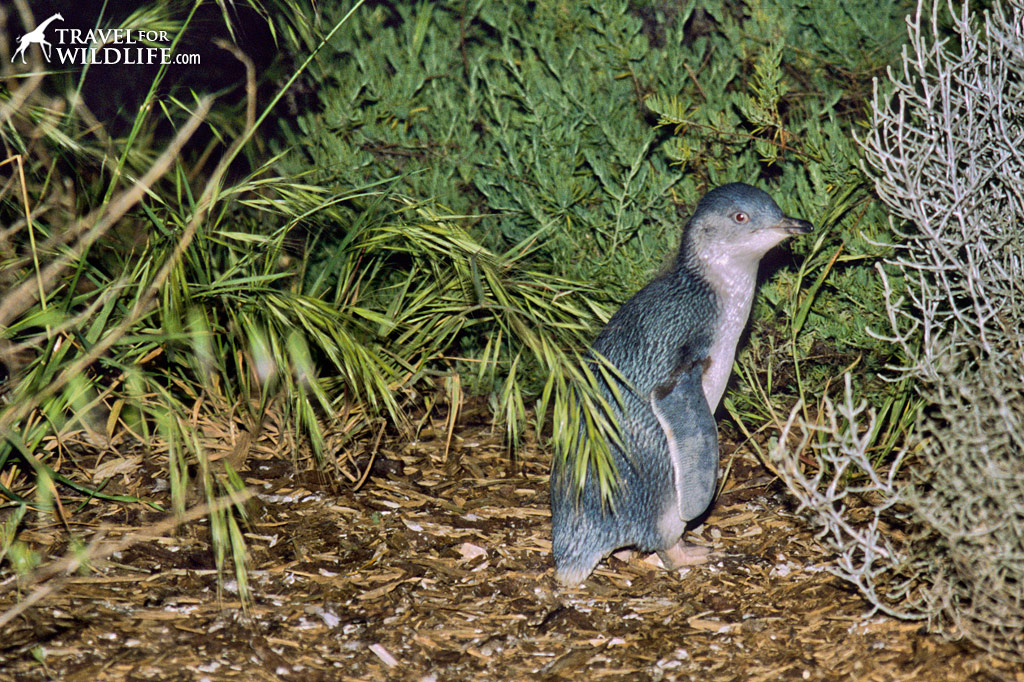Who’s that creepy little guy wandering around your backyard in the dark? If you live on the coast of New Zealand or the southern coast of Australia, then it’s probably the world’s smallest penguin. Appropriately named the Little Penguin (Eudyptula minor novaehollandia), but also known as fairy penguin (in Australia) or blue penguin, it stands only one foot tall and couldn’t even reach high enough to peck you in the kneecap.
Compare that to the world’s biggest penguin, the Emperor penguin, who is four times as tall, and you will see that this guy is truly a shrimp among his penguin cousins.
I photographed this little fellow sneaking around in a suburban backyard in Penneshaw on Kangaroo Island in South Australia. What is he doing wandering around in the dark? Little Penguins are considered the most nocturnal of the penguins and can often be seen returning to their burrows at dusk after a day spent foraging at sea. In towns like Penneshaw, many little blue penguins have picked up the habit of building burrows under homes and foundations when natural burrowing areas are scarce.
Is the blue penguin blue?
Yes, they are! While they have grayish faces, their backs are dark blue.
Little penguin facts
For two weeks between January and March, penguins will stay ashore continuously for around 2 weeks during their annual molt as their feathers are not waterproof yet. Once they grow all their feathers back, they can be waterproofed again. How?
To keep their feathers waterproof, little penguins rub their beaks into their uropygial gland (also called the preen gland) located near their tail and apply the oily substance through their feathers. Chicks don’t have these waterproof feathers and they have to stay on land until they grow them.
Blue Penguins are only active on land at night as they spend their day fishing for small fishes. When they are foraging, they can stay under the water for 20 to 30 seconds only at a time, and they dive an average of 800 times a day.
Fishing for slippery small fish (such as anchovies and sardines) makes feeding time difficult but the little penguin has a couple of adaptations that help them. For example, they have a hook on the end of their bill and they also have spikes on their tongue that are pointing towards the back of their mouth. This helps the penguins keep their trophies.
Blue penguins can swim up to 5 miles per hour
Blue penguins come ashore in groups, going from small groups of only few individuals, to groups as big as 100 penguins. These big groups of penguins are called ‘rafts’.
Blue penguins have a pretty salty diet. To regulate their salt, penguins have another useful gland. This gland is the supraorbital gland, located just above their eyes. How do these glands work? As the blood passed through the gland, the salt is trapped there. This excess salt is then mixed with moisture inside the gland, traveling down their nasal passage, and dripping out of the penguin’s nose!
The life cycle of the blue penguin
The average life span of fairy penguins is 7 years, they are only a foot tall and with a body weight of 2.2 pounds, these are the world’s smallest penguins. A male penguin is a bit bigger than a female.
In their natural environment, blue penguins normally burrow in colonies on rocky cliffs-bases. Vegetated sand dunes are also a good nesting site.
Blue penguins can raise up to 4 chicks per breeding season (in 2 different clutches). The egg incubation can take up to 36 days. Penguin chicks will fledge after 7-8 weeks. Since chicks are not waterproof and can’t get in the water just yet, the parents are very busy during the breeding season. They must fish for themselves and to bring food back to the chicks. During this time, the parents can swim up to 30 miles per day.
Threats to little penguins
Their natural predators are sharks, leopard seals, and sea lions.
Commercial fishing operations, oil spills, human encroachment and habitat destruction, and climate change are also threats to little penguins.
Introduced predators (including dogs, rats, cats, stoats, and ferrets) also have a detrimental impact on the survival of the little penguins.
How is climate change a threat to the little penguin?
With higher sea-surface temperatures, the little penguin has to swim farther away to colder waters to find food, spending some precious energy along the way. The farther away they have to swim to forage, the less food they can bring to their chicks. This can lead to chick starvation and death.
In June 2022, hundreds of dead birds washed up, dead along New Zealand beaches. Mass die-offs of penguins are not unheard of but conservation specialists fear that with climate change they’ll get worse. As the frequency of marine heatwaves and the frequency of storms increase, the little penguin’s life will be more difficult.
Where to see the little penguin?
Little penguins are found along the coastlines of southern Australia and New Zealand. If you want to see them in their natural habitat and don’t know where there are a couple of tours found in our post wildlife tours in Australia that see them regularly.
You can also take a night safari in Australia that is designed around seeing them at dusk as they come back to land after a day foraging at sea.
If you are in the Melbourne area you can also do a day trip from there to see them at Phillip Island Nature Park, the largest little penguin colony in the world. You can join their penguin parade to watch as the penguins arrive at the shore at dusk to return to their burrows. More information and ticket prices here.
In New Zealand, you can visit the little penguins at the Oamaru blue penguin colony in Oamaru, which is only 3h drive south of Christchurch.
Have you ever seen the smallest penguin in the world?

Cristina Garcia
Zoologist and wildlife photographer. She has worked in the field with jackals, wolves, cheetahs, & leopards. She serves on the Board of Directors of SEE Turtles, a non-profit sea turtle conservation organization.
Read her posts at Travel For Wildlife and see more of her work at Truly Wild, & Our Wild Yard.


Mary @ Green Global Travel
Thursday 5th of December 2013
Beautiful! What a pleasure it would be to find him sneaking around your back yard!